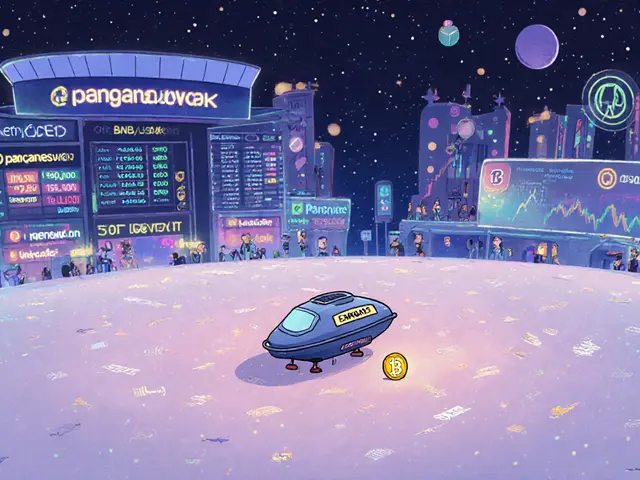Blockchain Sharding Calculator
Sharding Impact Analysis
Current Capacity:
15 TPS
Potential Capacity:
150 TPS
Shard Creation
Protocol splits network into parallel shards
Parallel Processing
Each shard handles transactions independently
Cross-Shard Communication
Secure message passing between shards
Data Availability
Cryptographic proofs ensure data integrity
Key Takeaways
- Sharding splits a blockchain into smaller shards that process transactions in parallel.
- Each shard runs its own consensus, reducing the load on individual nodes.
- Cross‑shard communication and data‑availability proofs keep the network safe.
- Major networks-Cardano, NEAR, Polkadot, and the upcoming Ethereum design-already use or plan sharding.
- Sharding boosts throughput dramatically, but adds complexity around security and coordination.
When we talk about sharding is a technique that splits a blockchain into multiple smaller pieces called shards, we’re borrowing an idea from traditional databases. In a blockchain context, sharding means every validator only needs to store and verify data for a subset of the whole network, freeing up compute, storage, and bandwidth. This horizontal scaling approach is the most promising answer to the age‑old "blockchain trilemma" of security, decentralisation, and scalability.
What Exactly Is Sharding in Blockchain?
Blockchain sharding is the process of dividing a single ledger into multiple parallel ledgers, or shards, each handling a fraction of the total transaction load. Imagine a highway that suddenly gets three extra lanes; each lane (shard) can carry cars (transactions) independently, so the overall traffic moves faster without needing a bigger road.
Traditional blockchains-Bitcoin, early Ethereum-require every node to download the entire history and verify every transaction. That works fine for a few dozen transactions per second, but it becomes a bottleneck when demand spikes. Sharding changes the rulebook: validators join specific shards, process only the transactions relevant to that shard, and then rely on a coordination layer to keep the whole network in sync.
How Sharding Works: Core Mechanics
Three moving parts keep a sharded network humming:
- Shard creation - The protocol splits the chain into n shards. The number can be fixed (e.g., 64 shards) or flexible, increasing as demand grows.
- Independent transaction processing - Users send their transaction to the shard that stores the accounts or smart contracts involved. Each shard runs its own consensus mechanism (often a Proof‑of‑Stake variant) to agree on the new block.
- Cross‑shard communication - When a transaction touches data on two shards, a special protocol ensures both shards see the change. This is usually done via cross‑shard messages that are relayed through a coordination chain or a set of validators that monitor multiple shards.
To maintain security, each shard must prove that its data is available to the rest of the network. This is where data‑availability proofs cryptographic evidence that a shard’s block can be reconstructed by anyone who requests it come in. If a validator tries to hide data, the proof fails and the block is rejected.
The coordination backbone is often called a Beacon chain in Ethereum’s design, a separate chain that assigns validators to shards and finalises their blocks. Other networks use a “relay chain” (Polkadot) or a “manager chain” (NEAR) for the same purpose.
Why Sharding Matters: Benefits
Scalability - By processing transactions in parallel, a network can theoretically reach throughput × numberofshards. Early tests on Ethereum’s testnets showed a jump from ~15TPS to over 150TPS with 10 shards.
Lower hardware requirements - Validators no longer need to store the full ledger. A node can run on a modest server or even a consumer‑grade laptop, widening participation and preserving decentralisation.
Cost efficiency - Less storage and compute mean lower validator staking requirements and cheaper transaction fees for users.
Flexibility - Different shards can specialise (e.g., one shard for DeFi contracts, another for NFTs), allowing tailor‑made optimisation for each use‑case.
Challenges and Trade‑offs
Sharding isn’t a free lunch. The biggest hurdles include:
- Cross‑shard complexity - Moving data between shards adds latency and requires robust messaging protocols. Mistakes can lead to double‑spends or state inconsistencies.
- Security fragmentation - If a shard has too few validators, it becomes easier for an attacker to take over that slice of the network. Protocols mitigate this by randomising validator assignments each epoch.
- Data‑availability attacks - Hiding shard data can stall the whole system. Advanced cryptographic proofs (e.g., erasure coding) are needed to prevent this.
- Implementation difficulty - Designing a seamless shard‑to‑shard hand‑off while keeping finality fast is a hard engineering problem. Many projects are still in experimental phases.
Real‑World Implementations
Several live blockchains have taken the sharding plunge, each with its own flavour.
| Network | Shard Count | Consensus per Shard | Coordination Layer | Status |
|---|---|---|---|---|
| Ethereum (Beacon‑chain design) | 64 (planned) | Proof‑of‑Stake (Casper) | Beacon chain | In rollout (post‑Merge) |
| Polkadot (Relay‑chain + parachains) | Up to 1,000 parachains | Nominated Proof‑of‑Stake (NPoS) | Relay chain | Live (2020) |
| NEAR Protocol (Nightshade design) | Dynamic, currently ~128 | Threshold Proof‑of‑Stake | Shard‑master (meta‑shard) | Live (2020) |
| Cardano (Hydra side‑chain approach) | Planned multi‑layer shards | Ouroboros PoS | Layer‑2 Hydra heads | In development (2024‑2025) |
All these projects share the same goal: process more transactions per second while keeping the network cheap and decentralized. Ethereum’s Beacon chain, for instance, acts like a traffic controller, assigning validators to shards each epoch and finalising their blocks.

Sharding vs. Layer‑2 Solutions
Layer‑2 solutions (e.g., rollups, state channels) sit on top of an existing chain and bundle many transactions into a single on‑chain proof. Sharding, by contrast, rewires the base layer itself. The key differences are:
- Fundamental vs. Overlay - Sharding changes how the ledger stores data; layer‑2 keeps the original ledger untouched.
- Security model - Sharding inherits the base chain’s security; layer‑2 security depends on the underlying chain plus extra fraud‑proof mechanisms.
- Complexity - Sharding adds coordination challenges across shards; layer‑2 adds complexity in aggregating proofs and handling withdrawals.
Looking Ahead: The Future of Sharding
Ethereum’s upcoming “Danksharding” iteration aims to push shard count beyond 256 and tighten cross‑shard messaging, making the technology viable for mass‑market dApps. Meanwhile, projects like Polkadot experiment with parachains that can be swapped in and out, offering a modular approach to scaling.
If sharding can solve the data‑availability and security puzzles cleanly, it will unlock mainstream use‑cases-high‑frequency trading, massive multiplayer games, and global supply‑chain tracking-without forcing users to rely on expensive roll‑ups or centralised intermediaries.
Frequently Asked Questions
What is the main difference between a shard and a full blockchain?
A full blockchain stores every transaction ever made; a shard only stores a subset of those transactions, letting validators work on a smaller dataset.
How does cross‑shard communication avoid double‑spending?
When a transaction touches two shards, the originating shard locks the involved assets and sends a cryptographic proof to the destination shard. Only after the destination confirms the receipt does the lock release, preventing the same asset from being spent twice.
Can a validator join multiple shards at once?
Yes, many protocols rotate validators across shards each epoch to spread security. However, a validator typically runs a limited number of shards simultaneously to keep hardware demands reasonable.
Is sharding compatible with existing smart contracts?
Most existing contracts can run on a sharded chain, but developers may need to handle cross‑shard calls explicitly or rely on libraries that abstract the communication layer.
Will sharding make transaction fees cheaper?
Generally, yes. By increasing throughput, the network reduces congestion, which typically leads to lower fees. The exact reduction depends on user demand and how many shards are active.






Nicholas Kulick
Sharding chops a blockchain into parallel segments, letting each handle its own transactions. This boosts throughput without sacrificing security.
Caleb Shepherd
People love to hype sharding as the miracle cure, but nobody tells you that the coordination layer could become a single point of control. If the validators collude, the whole multi‑shard network could be steered like a puppet.
Jason Wuchenich
Great breakdown! If you keep experimenting with the calculator you’ll see how adding shards scales linearly in ideal conditions.
Marcus Henderson
From a theoretical standpoint, sharding embodies the principle of distributed workload, akin to dividing a workload among multiple artisans to craft a single masterpiece. By ensuring each shard possesses its own state, the protocol upholds decentralization while pursuing scalability.
Andrew Lin
Look, the US tech giants cann't just hijack sharding tech to create a new digital empire. If they try to dominat the shard consensus, we’ll see a new kind of ctrl‑freaky surveillance!
Matthew Laird
Decentralization is a moral imperative; sharding must not become a tool for the powerful to tighten their grip. We should demand transparent cross‑shard protocols.
Caitlin Eliason
This article feels like a call to arms for the blockchain community! If we ignore sharding's potential, we betray the promise of open finance.
Ken Pritchard
If you're just starting, think of shards as separate lanes on a highway; each lane moves its own cars, which keeps traffic flowing smoothly.
Dawn van der Helm
Love the visual breakdown! 🚀 Sharding really does make the network feel like a well‑orchestrated band.
Michael Phillips
While the throughput gains are appealing, the overhead of cross‑shard messaging can offset some of the performance benefits, especially under load.
Liam Wells
It is evident, dear readers, that the presented calculator glosses over the substantial latency introduced; consequently, the purported tenfold increase is, at best, a theoretical abstraction.
Ritu Srivastava
Honestly, the optimistic tone makes me cringe; real networks suffer from validator churn and network partitions that invalidate such pristine numbers.
Franceska Willis
Whoa, this sharding stuff is like a kaleidoscope of blockchain magic-every shard spins its own funky beat!
EDWARD SAKTI PUTRA
I understand the excitement, but remember that implementing sharding requires careful testing and community consensus.
Bryan Alexander
Push forward, innovators! The world needs bold sharding experiments to break the current bottlenecks!
Patrick Gullion
Sure, sharding sounds cool, but scaling can also be achieved with layer‑2 rollups; sometimes the hype overshadows simpler solutions.
Jack Stiles
Nice tool, shows the difference quickly. Might try with 5 shards next.
Monafo Janssen
I appreciate Jason’s encouragement and would like to expand on the practical steps for newcomers.
First, always start with a modest number of shards, such as two or three, to observe how the network behaves.
Monitoring latency between shards is crucial because cross‑shard communication can become a hidden bottleneck.
Second, make sure the validator set is sufficiently diverse to prevent centralization within any single shard.
Third, test the system under realistic transaction mixes rather than synthetic uniform loads.
Real‑world usage often includes a blend of simple transfers and complex smart‑contract calls, which impact performance differently.
Furthermore, consider the impact of state‑pruning strategies on data availability across shards.
If shards prune too aggressively, you may lose the ability to reconstruct historical proofs.
Another tip is to instrument your nodes with metrics dashboards that track per‑shard throughput and error rates.
These dashboards help you spot anomalies early before they cascade into larger outages.
Community governance also plays a role; involve stakeholders in decisions about shard rebalancing.
Transparent proposals and open discussions foster trust when adjustments are needed.
Lastly, remember that scalability is an ongoing journey, not a one‑time configuration.
Iterate, gather feedback, and adjust the shard count as the network grows.
With patience and systematic testing, sharding can truly unlock the next level of blockchain performance.